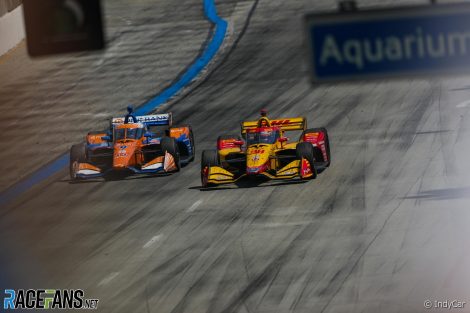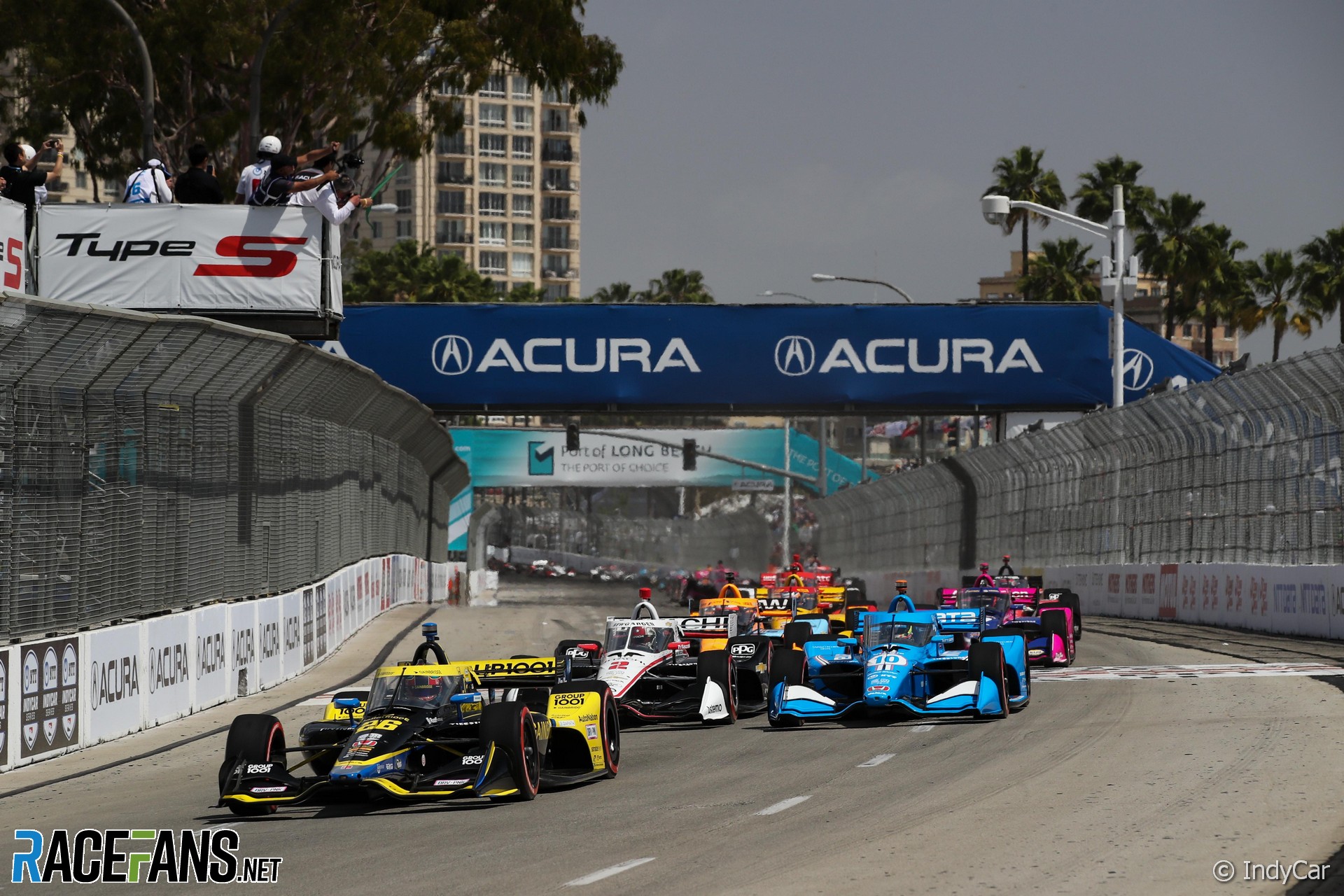Alexander Rossi believes IndyCar’s Long Beach Grand Prix would produce more exciting races if the distance was extended.
Since 2017 the race has run to 85 laps (269 kilometres), a distance it previously ran to from 2009 to 2012. Rossi believes this length leads teams to use similar refuelling strategies which creates processional racing.“Qualifying [at every race] is very critical, but especially Long Beach because when it works out, it’s a pretty straightforward two-stop race,” explained Rossi ahead of IndyCar’s annual visit to the track this weekend.
“There’s not many yellows, it’s a pretty clean race, historically speaking. So the leader doesn’t really get hung out by a closed pit situation type of thing.

This puts the onus on drivers making passes on-track rather than depending on pit strategies, as is often the case in other street races where caution periods can be more common.
Nonetheless the race has produced surprise results. Two years ago, when the race was unusually held at the end of the season when it returned to the schedule following a Covid-enforced absence, Colton Herta came from 14th on the grid to win.
Advert | Become a RaceFans supporter and
Herta made eight on-track passes in the opening stint of the race, dropped to 21st with his first pit stop, then recovered to 15th before several drivers ahead pitted during a caution period. That lifted him up to sixth in the space of a lap, and once green flag action resumed he only took four laps to make his way into the lead.
But Rossi, a two-times winner at this track, believes a longer race distance may make the race even more exciting.
“I’m kind of in the opinion that we can make Long Beach a little bit longer, so then you can have the two options. I think some of our best races are when you’ve got guys on a fuel-save two-stop, and then other guys on a flat-out three-stop race trying to make up that pit lane difference.
Advert | Become a RaceFans supporter and
“It’s been this length for a long time, it’s put on some great shows. Colton in ‘21, where he started 14th and ended up winning and there wasn’t really any yellows that he had to help him. So if you have a strong car, like always in IndyCar, you can usually have a pretty good result. But yes, in a perfect world, we’d probably extend it a little bit.”
Another unusual feature of the Long Beach race is the impact the support bill has on the way the track evolves over a weekend. Its usual single-seater junior series absent and the Hypercars and GT3 sports cars of IMSA share the weekend bill instead. IMSA crams all of its sessions into Friday and Saturday, including their 100-minute ‘sprint race’, and lay down rubber with different quantities to what Indy Nxt and the USF Pro championships usually do.
However an unusual decision by the organisers meant this did not have its usual effect on grip levels last year, said Rossi.
“Last year was a weird one,” he reflected. “They put a sealant down, the city did, and the track grip was insane from lap one of practice one. So the grip – the other running of the other cars didn’t really change anything because the grip level started incredibly high anyways. Pole was a new track record and it was crazy fast all weekend.
“Usually, it’s a really beneficial thing [having IMSA here] because it starts out as a very low-grip green surface because it hasn’t been used as a race track in a year, and having all of the different stuff – especially IMSA – on track really helps speed up the evolution of the track.
“So I don’t know what it’s going to be like this year. If that sealant will still have the same effect, or if it’s worn off after California got pummelled with rain for seemingly five months. I don’t know, we’ll have to see, but usually it’s just a good thing in terms of getting the cars up to speed.”
Advert | Become a RaceFans supporter and
IndyCar
- Two Penskes disqualified from season-opener, O’Ward handed victory
- Pourchaire to make second IndyCar start for McLaren as Malukas’ absence continues
- Dixon sips fuel to win as Newgarden and Herta collide in his mirrors
- Rosenqvist beats Penske pair at Long Beach to give Meyer Shank first pole
- F2 champion Pourchaire to make IndyCar debut for McLaren at Long Beach





Mark Zastrow (@markzastrow)
14th April 2023, 8:57
When people bring up the prospect of bringing back refueling in F1, whether for the sake of strategy or lighter cars, I think this is often an overlooked aspect. To make a refueling race interesting, you have to be able to tweak the race length to bring different strategies into play. It’s common practice in IndyCar, where there’s never been a set distance for races. Would the FIA be willing to move away from the sacred 305-km grand prix distance for the sake of the racing?
S
14th April 2023, 11:50
We can all be extremely confident that even if the FIA were willing to be more flexible, it would be met with resistance of immense proportions from F1’s gatekeepers – such as the people who write for and comment at this very site.
The teams would only be up for it if they were given something they wanted. But what more is there that they could possibly want that they haven’t already bargained for?
Indycar provides a better on-track product than F1 for almost every imaginable reason – refuelling is just one of them.
The more strategic variables you give the teams at the event, the less predictable the races will be – obviously all made possible by giving them all ~equal chance of success prior to even arriving at the track.
Something F1 could do too… But, well, those gatekeepers….
Lee Stavola
14th April 2023, 20:35
F1 would never go for refueling for whatever reason there was way to many pit fires compared to Indy car but I think it would definitely make it more interesting 🙂
GT Racer (@gt-racer)
14th April 2023, 12:34
Reason they shortened it was to try and minimise fuel saving which is something the various incarnations of Indycar has been trying to limit for 20 years or so.
Fuel saving and lift and coast was a big factor in the races and becoming a bigger factor in the late 90s/Early 00s and fans didn’t like it so they wanted to reduce it.
Champcar initially tried the mandatory pit windows (Which caused more problems) and since then the series has tried shorter races, Removing the fuel mixture settings, Giving them more fuel and probably some other things.
Steve Holmes
14th April 2023, 15:04
I first went to Long Beach in 1979. It was a much different place then. Gone now is the Linden avenue hill. A 300 foot drop that starts with a right and then massive Slides happen as the cars transition to the fast left at the bottom. The morals left on the road were impressive. Plus the sound. OMG
I wonder if Mr Rossi even is aware of LBGPs past? Once a great race track